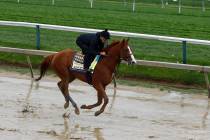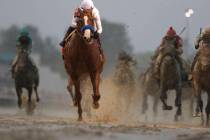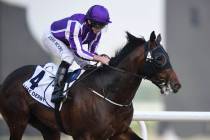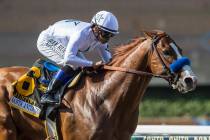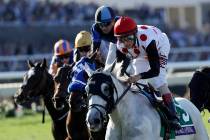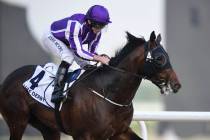In the year since this column debuted, we have handicapped 94 races at 24 different tracks and show a profit of $20.10 on a mythical $2 win bet on the handicappers’ top picks. That works out to a return on investment of $2.20.
- Home
- >> Sports
- >> Sports Columns
Mike Brunker

Mike Brunker is an assistant city editor at the Review-Journal and he writes a weekly horse racing column. The column is posted on Thursday's and appears in Friday's print edition. He previously covered horse racing for the San Francisco Examiner, the Thoroughbred Times and NBCSports.com. Follow @mike_brunker on Twitter
A chain of events during the early stages of the race that appear to have been orchestrated to achieve a Triple Crown sweep by Justify leave a sour taste in the mouths of many racing fans.
The Bob Baffert-trained son of Scat Daddy already had rewritten racing’s history books by breaking the so-called “Curse of Apollo,” becoming the first horse to win the Kentucky Derby without having raced as a 2-year-old.
Kerry Thomas, a self taught equine sports psychologist, says the Kentucky Derby and Preakness Stakes winner “has the mental aptitude and physical ability to win the Triple Crown.”
Racing fans who watched the second jewel of the Triple Crown came away with two distinct impressions of the race: Either Justify showed his mettle when tested for the first time or he showed he’s topped out and is on the way down.
The Kentucky Derby winner is 2-5 on the morning line for the second jewel of the Triple Crown, but he still has some questions to answer.
The Bob Baffert-trained colt ran a strong race to end the “curse of Apollo,” but his favorable trip over the “sloppy” racetrack means that questions remain to be answered before he can be considered one of the great ones.
The 3-1 favorite should get a favorable pace scenario, but can he last 1 1/4 miles? See what horse racing columnist Mike Brunker, the #RJhorseracing handicappers and guest experts Bob Ike, Patrick McQuiggan and Ellis Star think.
Narrowing the field to a manageable number of horses that you can return to when post positions are drawn for the Run for the Roses on Tuesday will give you an edge over handicappers who are grappling with a 20-horse field.
Speed figures are a great tool, but they are not a reliable crutch when it comes to deciphering a race as complicated and unique as the Run for the Roses.
The last two prep races for the Run for the Roses – the Arkansas Derby and Lexington Stakes – will be run on Saturday, leaving handicappers a mere three weeks to make sense of what has been an exhilarating run up to the main event.
If we didn’t see the Kentucky Derby winner last week, then we almost certainly will on Saturday when the Wood Memorial, the Blue Grass Stakes and the Santa Anita Derby lure most of the top guns for the Run for the Roses.
The Group 2 UAE Derby — part of a stellar Dubai World Cup card — and the Grade 1 Florida Derby at Gulfstream Park make for a challenging handicapping challenge, part of which involves getting up early Saturday.
With just six weeks until the Kentucky Derby, give or take a day, most horses being aimed for the race are going to run just once more to try to secure a spot in the starting gates.
The Bob Baffert-trained colt has been spectacular in the first two races of his career, but his lack of seasoning raises questions about whether he’ll be ready for the moving mosh pit that is the Kentucky Derby.













